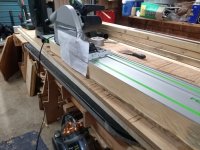mac sparrow
Member
- Joined
- Dec 14, 2013
- Messages
- 240
I'm trying to see if there is anything else I can do to reduce how much dust my TSC55 kicks up. I have a ceiling mounted air filter running when I'm cutting, I use a dust extractor, I keep the splinter guard down. That's all I use and I'd like to improve dust collection if that's at all possible.
Here are some ideas I was simply thinking about but I'm not committed to any of them and would appreciate input:
Thanks for your time
Here are some ideas I was simply thinking about but I'm not committed to any of them and would appreciate input:
- Arbor coverhttps://www.ebay.co.uk/itm/23366570...enc:1TR-hf-wzTH-L4fQZfvlYPQ4&_trkparms=ispr=1
- Cover ABSAhttps://www.festool.co.uk/accessory...and-attachments/577341---absa-ts5560#Overview
- Some kind of open spout that captures any flying dust locally to the track saw. Imagine a 3D printed spout thingy that attaches to the workbench near to where the track saw cuts and then has a port that connects to a dust extractor so when you're cutting the open spout has suction on it and catches the flying dust. If that makes sense?
Thanks for your time

